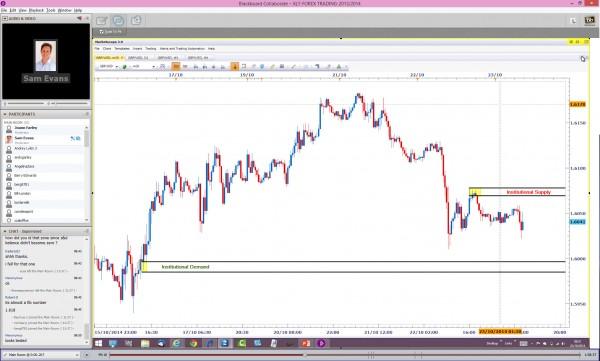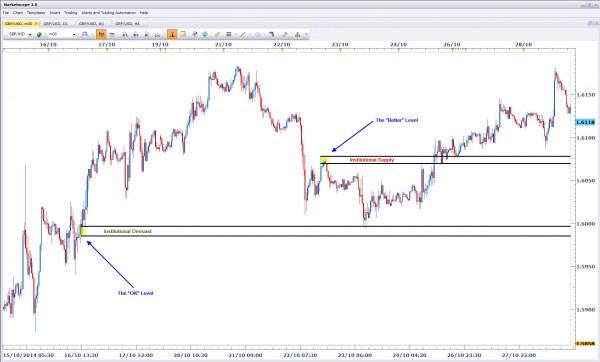![]()
Since returning to London after my extensive trip of the United States, I have mainly been focused on my own trading and conducting regular sessions in the Online Trading Academy live XLT room. Each XLT session lasts for about two hours in duration and involves live trading and analysis in real time market conditions. The sessions are perhaps one of my favorite things to do out of my various duties as an instructor and mentor with OTA. I enjoy the environment mainly because it gives me the ability to interact with the students as things are happening right in front of us, allowing me to answer their questions as they come along and get a good sense of what they are thinking as they prepare to take trades.
The reason I think that this is such an important dynamic within the XLT is because, as I’ve mentioned many times before in my previous articles, the mental game or the nature of one’s psychology plays such a huge part in the overall success of a trader’s system and methodology. I like my students to question an opportunity and weight consequences on the outcome of that trade before it even happens. As human beings this is a natural part of our thought process, considering that we are programed on the deepest sub-conscious level to consider both the good and the bad outcomes of any action that we take. Obviously with this in mind, the activity of trading invites us to question the outcomes and possibilities of that trading opportunity just like we would anything else. Sometimes a great setup can be right in front of us, yet we find it almost impossible to place the trade because we’re already concerned with what may or may not happen if the trade does indeed reach the entry point.
I invite you to consider this system of events within your psychology and to look at the times when you may have done the same thing yourself in your own currency trading. Let me now address a live XLT program, which I led a few weeks ago. The session like many others, presented us with a varying degree of trading opportunities throughout the two-hour duration and as we looked over and analyzed the information that the market was providing us with, we highlighted key setups, which matched our patented core strategy. Here at OTA, the patterns that we look for are based on the institutional levels which are created by unfilled orders. If there are more willing buyers than there are willing sellers at any given price, this results in demand being greater than supply, therefore prices must rise. Likewise if there are more willing sellers than willing buyers at a price level, this equates to supply now being greater than demand and so we would expect prices to fall. Institutions have the greatest amount of firepower in the markets and so it is their unfilled orders which we look for on the charts, as they have deep enough pockets to create such large and imbalances between demand and supply. The biggest market players may not be speaking to tell you what they are doing and why they are doing it but if you know what you’re looking for and you can be objective in your analysis, you can find their footprints when they leave them behind. Take a look at the below example:
The above chart represents the GBPUSD currency pair and is taken from a snapshot of a live XLT session I was holding around the open of the London session. According to my analysis the pair was beginning to show some strength after a longer term downward trend had been taking place. The chart was telling me that now was not the time to do anything, however there was a low risk, high reward buying opportunity a little lower around 1.6000, shown to me by the way prices had strongly rallied from the area where the institutions had been attempting to buy the pound before. The supply zone above current price was also a good shorting opportunity for a short-term trade but did not offer quite as much potential profit as the lower buying opportunity. Having gone through the analysis with the students in the room, we drew out lines as you can see and set up our orders.
As is quite common after finding a setup, some of the students wanted to talk about the opportunities before placing their trades. I remember clearly that one student in the room did not feel comfortable with the buying setup I had highlighted on the chart as he felt that the level was not good enough. The same student did like the upper shorting opportunity however because he felt it was a good level based on its structure. This discussion led to an interesting look at the labels that we like to put upon things and the significance and importance this then gives them.
When a student was explaining to me why he did and didn’t like the levels, I invited him to consider what his meaning of a ”good” level and a “bad” level actually was. His response was solid and he told me that he based his description of the levels upon the odds enhancers scoring system he learned in class. It turned out that his analysis was suggesting to him that the demand zone had a one point lower score than the supply zone and because of this, he did not want to take the low buying opportunity. I praised his objective analysis because this is what I want to see the new traders do. Most new traders make emotional buying and selling decisions in the marketplace but here was a student learning that rules were the most important part of building consistency in FX trading. However, after the session had finished I e-mailed him and asked in what his scores were on a grade of 1 to 10 for both levels. He responded to me saying that that the demand level came out as an 8/10 and the supply level came out as a 9/10, hence him choosing the shorting opportunity over the buying opportunity. Let me show you now how the setups worked out:
The above chart shows the outcome of both trading opportunities and we can clearly see that the supply zone and the demand zone both produced great results. While the upper supply zone only gave us a trade of around a 3:1 reward to risk ratio (which is great), the lower institutional demand area gave us a much longer-term wealth trade with a far higher reward to risk ratio in excess of 8:1. My point is this: you can have a number of setups in front of you and it is vital to have trading rules to distinguish between the opportunities you are happy to consider and those which you are not.
We do have to ensure that we have a logical cut off point that does not also remove us from a worthwhile trading setup. My suggestion would be to employ a rules-based trading plan which allows you to grade your setups, much like our students who use the OTA odds enhancers and then take trades which come out at a high enough score and discard those which fall below that. This way you will avoid the common issue of attempting to cherry-pick your trades and end up not taking each and every one that actually meets your trade plan requirements. Plan the trade then trade the plan without trying to second guess yourself and you will no doubt begin to achieve the all important consistency required for successful trading and investing in today’s global currency markets. I hope this was helpful for you.
Note: All information on this page is subject to change. The use of this website constitutes acceptance of our user agreement. Please read our privacy policy and legal disclaimer. Opinions expressed at FXstreet.com are those of the individual authors and do not necessarily represent the opinion of FXstreet.com or its management. Risk Disclosure: Trading foreign exchange on margin carries a high level of risk, and may not be suitable for all investors. The high degree of leverage can work against you as well as for you. Before deciding to invest in foreign exchange you should carefully consider your investment objectives, level of experience, and risk appetite. The possibility exists that you could sustain a loss of some or all of your initial investment and therefore you should not invest money that you cannot afford to lose. You should be aware of all the risks associated with foreign exchange trading, and seek advice from an independent financial advisor if you have any doubts.
Editors’ Picks
AUD/USD failed just ahead of the 200-day SMA

Finally, AUD/USD managed to break above the 0.6500 barrier on Wednesday, extending the weekly recovery, although its advance faltered just ahead of the 0.6530 region, where the key 200-day SMA sits.
EUR/USD met some decent resistance above 1.0700

EUR/USD remained unable to gather extra upside traction and surpass the 1.0700 hurdle in a convincing fashion on Wednesday, instead giving away part of the weekly gains against the backdrop of a decent bounce in the Dollar.
Gold keeps consolidating ahead of US first-tier figures

Gold finds it difficult to stage a rebound midweek following Monday's sharp decline but manages to hold above $2,300. The benchmark 10-year US Treasury bond yield stays in the green above 4.6% after US data, not allowing the pair to turn north.
Bitcoin price could be primed for correction as bearish activity grows near $66K area

Bitcoin (BTC) price managed to maintain a northbound trajectory after the April 20 halving, despite bold assertions by analysts that the event would be a “sell the news” situation. However, after four days of strength, the tables could be turning as a dark cloud now hovers above BTC price.
Bank of Japan's predicament: The BOJ is trapped

In this special edition of TradeGATEHub Live Trading, we're joined by guest speaker Tavi @TaviCosta, who shares his insights on the Bank of Japan's current predicament, stating, 'The BOJ is Trapped.'
RECOMMENDED LESSONS
Making money in forex is easy if you know how the bankers trade!
Discover how to make money in forex is easy if you know how the bankers trade!
5 Forex News Events You Need To Know
In the fast moving world of currency markets, it is extremely important for new traders to know the list of important forex news...
Top 10 Chart Patterns Every Trader Should Know
Chart patterns are one of the most effective trading tools for a trader. They are pure price-action, and form on the basis of underlying buying and...
7 Ways to Avoid Forex Scams
The forex industry is recently seeing more and more scams. Here are 7 ways to avoid losing your money in such scams: Forex scams are becoming frequent. Michael Greenberg reports on luxurious expenses, including a submarine bought from the money taken from forex traders. Here’s another report of a forex fraud. So, how can we avoid falling in such forex scams?
What Are the 10 Fatal Mistakes Traders Make
Trading is exciting. Trading is hard. Trading is extremely hard. Some say that it takes more than 10,000 hours to master. Others believe that trading is the way to quick riches. They might be both wrong. What is important to know that no matter how experienced you are, mistakes will be part of the trading process.



